
COVERING THE TAMPA BAY AND ITS WATERSHED |
|||||||
|
Stunning Yards Are Florida-Friendly Too
In another sun-drenched garden, butterflies hover over the rich purple blooms of perennial salvia thriving against a backdrop of passionflower. A shady side yard is brightened by a row of crotons with yellows, oranges and greens so vibrant they don't look real. And in Donna Donner's landscape, bromeliads bloom so abundantly that strangers stop on the street to ask her for a tour. While all of these landscapes are stunning, they have more in common than meets the eye. They're designed to be Florida-friendly so they minimize impact on the environment - plus save money and time for their owners. In fact, when Don and Jackie Anderson starting planting crotons at their Largo home, they were as concerned with cutting back on maintenance as they were with saving water. "Most people they think they're supposed to have this big green lawn but there isn't any lawn grass indigenous to Florida so they are all going to take an incredible amount of energy to maintain," he says. "We asked ourselves is a lawn really worth that much trouble and decided we'd rather sit back, drink mint juleps and watch our neighbors do all the work." No other plant takes anywhere near as much maintenance as a lawn, adds garden writer Monica Moran Brandies. "Would you even consider using another plant that requires weekly pruning during the summer, plus regular applications of fertilizers and pesticides, and water every week?" she asks rhetorically. A Desert With Rain Water, of course, is critical in a state some gardeners call "a desert where it rains all summer." Watering a typical 5,000 square-foot landscape with an underground irrigation system may account for up to half of a homeowner's total water use during dry months - at a cost of $4 to $10 every time the sprinklers go on.
Overwatering washes away fertilizers and may cause diseases that force homeowners to use pesticides and fungicides. When overwatering continues, those toxic substances and nutrients wash off yards and into storm drains. Stormwater runoff is now the single largest source of pollution in Tampa Bay and residential areas alone contribute a whopping 14% of the total nitrogen loadings to Tampa Bay - the third-largest source of the bay's most damaging contaminant. Recognizing that residential runoff would become a critical issue, the Sarasota and Tampa Bay Estuary Programs helped create the Florida Yards & Neighborhoods initiative in 1992 through the local cooperative extension service. "We'd been successful at controlling many of the point sources and it was clear that stormwater was going to become the top contributor of nitrogen," said Richard Eckenrod, executive director of TBEP. Working with the University of Florida and its county extension offices, the Florida Yards program demonstrates how to create Florida-friendly landscapes that are attractive and minimize damaging run-off, plus save money and maintenance time. Water-Wise Awards Set Benchmarks In 1997, Tampa Bay Water, with funding from the Southwest Florida Water Management District, created the Water-Wise Awards program to recognize builders and homeowners who conserve water by irrigating efficiently. Builders like M/I Homes in Hillsborough and Pasco, and Gibraltar Homes and Lee Wetherington Homes in Manatee County - to name a few recent winners - are proving that Florida-friendly is also very attractive and potentially profitable. The key, says long-time irrigation contractor Peter Politis of Niagara Sprinkler Systems, is using water-thrifty micro-irrigation systems in heavily mulched beds, minimizing turf areas and carefully designing spray heads for consistent coverage. "It takes a little longer to install, so it's more expensive up front, but over the long term a homeowner will save a lot of money," says Politis who has won multiple Water-Wise awards as a subcontractor to M/I Homes. To help customers understand the difference, Politis has met with M/I sales representatives so they understand the benefits, including a more attractive landscape and monthly savings on water bills. "Once homebuyers understand that they're protecting their landscaping and saving money, they see why they should spend a little more upfront," he said. Niagara also worked with its supplier to create a CD on how and why to adjust the irrigation controller. "It's one thing to read it and another to watch how it's done," he said. "Lawns only need an inch of water a week, but think how many weeks we get that much rain. If we educate homeowners on how and why to adjust their timers, we're talking about a lot of savings." Florida-Friendly is Marketing Tool M/I and other builders are now using attractive and environmentally sensitive Florida yards as a marketing edge in a highly competitive industry. "The quality of the landscape and irrigation system is part of our company's focus on building a quality, affordable product," says Theresa Lynn Collins, assistant division president for M/I Homes of Tampa. "We put our money into customer service and satisfaction, and our customers keep coming back - plus bring their friends and family." Upscale condominiums by JMC Communities also have won multiple Water-Wise Awards. "At our price range, properties need to look beautiful but we've always felt strongly about conserving as much of our natural resources as possible," says Michael Cheezem, founder and CEO.
At Magdalene Reserve in north Tampa, innovative engineering and landscape techniques resulted in a neighborhood where homes are nestled among oaks, magnolias and palmettos with a series of swales to capture stormwater before it leaves the site. "Development costs were comparable but the homes sold more quickly than those in similar subdivisions and residents are receiving long-term savings from reduced use of water, pesticides and fertilizers," says Thomas Levin, president of Ekistics Design Studio. The fact that homesites are much more attractive than a typical lot was critical in selling homes at River Forest in Bradenton, adds Joe King, architect and developer. "We bought the land as a buffer between King Ranch and the mobile home park to the south of us, and we wanted to do it right." At first, selling heavily wooded lots with swales for runoff was challenging but as people saw how well homes fit on the sites, the community sold out quickly. "Our residents really appreciate the difference," he says. "Many of them have taken the extra step and become certified Florida yards."
"Still, savvy builders and landscape designers are finding that Florida-friendly yards and residential developments that complement rather than compete with nature boost sales," says Bracciano. "It's creating a new marketing niche with great potential."
|
|||||||
|
|||||||
|
© 2004 Bay Soundings
|
|||||||
|
|||||||
 The hot pink blooms of a mandevilla contrast with deep emerald-green foliage spilling over a wooden mailbox. Nearby, brilliant blue blooms on a plumbago seem to reflect the color of the sky and compliment the sunshine-yellow flowers of gold mound lantana.
The hot pink blooms of a mandevilla contrast with deep emerald-green foliage spilling over a wooden mailbox. Nearby, brilliant blue blooms on a plumbago seem to reflect the color of the sky and compliment the sunshine-yellow flowers of gold mound lantana.  A large amount of that water may be wasted, notes Dave Bracciano, demand management coordinator for Tampa Bay Water, which supplies water to many utilities in the region. Inefficient irrigation systems apply more water than necessary and homeowners often confuse the days they're allowed to water with the days they should water (
A large amount of that water may be wasted, notes Dave Bracciano, demand management coordinator for Tampa Bay Water, which supplies water to many utilities in the region. Inefficient irrigation systems apply more water than necessary and homeowners often confuse the days they're allowed to water with the days they should water ( Developing Dolphin Cay on Boca Ciega Bay called for thousands of native plants to replace nuisance vegetation and build a natural wildlife corridor along the waterfront. At The Grande on Sand Key, native vegetation planted to anchor the beach with new dunes restored natural systems so effectively that shorebirds returned to nest in areas they had previously abandoned. "We like to think that we actually delivered (wildlife) habitat that was more productive after development than it was before," Cheezem said.
Developing Dolphin Cay on Boca Ciega Bay called for thousands of native plants to replace nuisance vegetation and build a natural wildlife corridor along the waterfront. At The Grande on Sand Key, native vegetation planted to anchor the beach with new dunes restored natural systems so effectively that shorebirds returned to nest in areas they had previously abandoned. "We like to think that we actually delivered (wildlife) habitat that was more productive after development than it was before," Cheezem said. Even as attractive as Florida-friendly landscapes can be, many homeowners still seem to prefer vast expanses of lush green lawns that require huge amounts of water, fertilizer and pesticides. Cities and counties have changed building codes to require water-conserving landscapes, but retrofitting the thousands built in the last 20 years will be an enormous job. And while almost everyone appreciates the improvements in Tampa Bay, it's difficult to explain how a landscape located miles away can have such an important impact.
Even as attractive as Florida-friendly landscapes can be, many homeowners still seem to prefer vast expanses of lush green lawns that require huge amounts of water, fertilizer and pesticides. Cities and counties have changed building codes to require water-conserving landscapes, but retrofitting the thousands built in the last 20 years will be an enormous job. And while almost everyone appreciates the improvements in Tampa Bay, it's difficult to explain how a landscape located miles away can have such an important impact.
